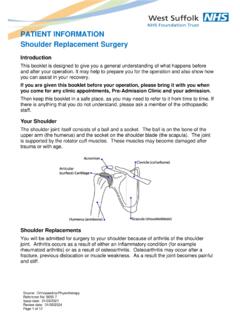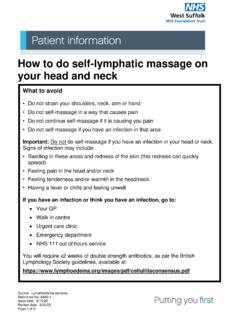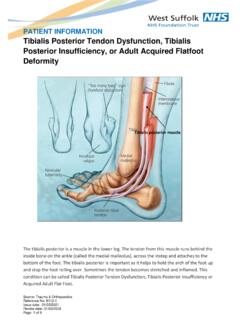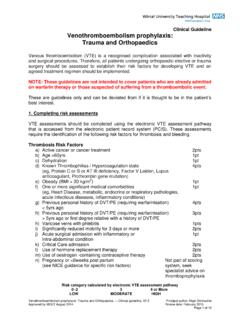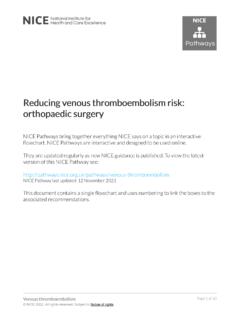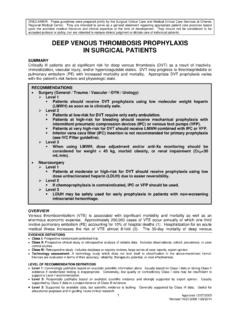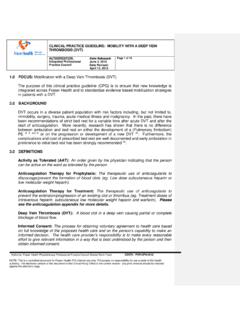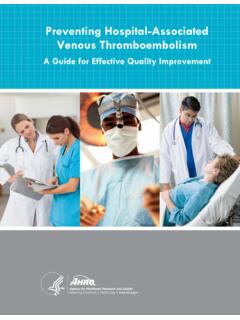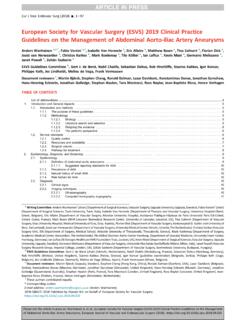Transcription of Midfoot arthritis - midfoot fusion / arthrodesis surgery
1 Source: Trauma and Orthopaedics Reference No: 6261-1 Issue date: 01/03/2021 Review date: 01/03/2024 Page 1 of 8 Navicular Cuboid Medial Cuneiform Intermediate Cuneiform Midfoot arthritis - Midfoot fusion / arthrodesis surgery The Midfoot The Midfoot refers to the bones and joints that make up the arch and connect the forefoot to the hindfoot. Midfoot arthritis can be caused by degeneration (osteoarthritis) or inflammation ( rheumatoid arthritis ). In both cases the cartilage, which is the shiny white tissue that lines and articulates the joint, becomes damaged. This causes bone to rub on bone, which is painful and can lead to deformity and stiffness. Osteoarthritis is often secondary to damage to the joint, for example as a result of previous fracture or injury, malalignment of the foot or infection.
2 Excess body weight can overload a joint and worsen the symptoms of arthritis . What are the symptoms? Pain: Pain is the commonest and most troublesome symptom. This is usually made worse by walking. It may disturb sleep. Simple ways to see if your pain is getting worse is to record whether your walking distance is decreasing, or whether you need more painkillers to ease the pain. Lateral Cuneiform Metatarsals Page 2 of 8 Stiffness: With osteoarthritis, stiffness or reduced movement is common. With inflammatory arthritis , stiffness can often be worse first thing in the morning. Cracking/popping: There may be little pieces of loose cartilage or bone caught within the joint causing this sensation. Giving way: This may be due to looseness of the ligaments, or secondary to pain.
3 Swelling: Swelling may be as a result of extra bone or fluid within the joint. The soft tissues can also inflame and swell. How is Midfoot arthritis investigated? X-rays of the foot are taken whilst you are standing. This simple test will give the most information on whether the Midfoot is worn or not. Blood tests are sometimes used to investigate inflammation. Occasionally special tests are needed to determine the extent of the arthritis , or exactly which joint is involved. An MRI scan can give a lot of information on the thickness of the cartilage lining the joint and whether there are small areas of wear and loose cartilage. CT and bone scans may also be used to investigate Midfoot arthritis . Treatment With any form of arthritis there are two forms of treatment.
4 The first is without an operation, and the second is with surgery . Most arthritis can be treated without surgery , and only in severe arthritis will surgery be considered. Non operative treatments In the first instance simple modifications of the way you lead your life should be tried. These include resting when the pain necessitates, slowing down and altering sporting activities. Weight loss, insoles within shoes, supportive boots and walking sticks are also useful. The most important and effective non-operative treatment if necessary is weight loss. Pain relief Pain killers such as paracetamol can be effective. Non-steroidal anti-inflammatories (NSAID), such as brufen, ibuprofen and diclofenac can reduce inflammation. Patients need to check with their general practitioner or pharmacist that NSAID's are suitable for them, as they can have side effects, especially if you have asthma or stomach Page 3 of 8 ulcers.
5 Physiotherapy and hydrotherapy can help with pain and stiffness. Patients with inflammatory arthritis are usually looked after by a rheumatologist. Disease-modifying anti-rheumatoid drugs (DMARD s) are used to treat these conditions, in conjunction with painkillers and NSAID's. Operative treatments Steroid injection: Steroid injection of the affected joint or joints may be an option that may provide temporary relief from pain (depending on the joints involved). It may be possible for the injection to occur under ultrasound guidance within the x-ray department. Often, the procedure will require admission to hospital usually as a day case with the injection taking place in an operating theatre with x ray facility to identify the affected joint/s for injection.
6 Injection is not a cure for the condition but can provide temporary relief of pain. Midfoot fusion surgery : Midfoot fusion , also referred to as arthrodesis , is a procedure in which the separate bones that make up the arch of the foot are permanently fused into a single mass of bone. fusion eliminates the normal motion that occurs between these bones. What are the goals of a Midfoot fusion ? The primary goal of Midfoot fusion is to decrease pain and improve function. Eliminating the painful motion between arthritic joint surfaces and restoring the bones to their normal positions achieves this. Other goals include the correction of deformity and the return of stability to the arch of the foot. A successful Midfoot fusion can achieve these goals and restore more normal walking ability.
7 Page 4 of 8 At left, this standing X-ray view of a right foot shows an abnormal gap between the first and second metatarsals (arrow). At right, this side X-ray view of the same foot shows loss of alignment. In a healthy foot, the two lines would overlap one another. Midfoot fusion can involve all of the Midfoot joints. More commonly just one or a few of the joints are fused. The joints of the Midfoot do not bend and move like your knee or elbow. They are designed to be relatively stiff to give your foot strength and support your body. Midfoot fusion does not generally produce much noticeable loss of motion because there is fairly little motion to begin with. This standing x-ray view of a right foot shows degeneration/ arthritis between the mid foot bones.
8 A healthy foot would show clean lines and spaces between the bones. Midfoot fusion aims to correct both problems. When should I avoid surgery ? Midfoot fusion should not be performed if there is active infection or if the patient s health is poor enough that the risk of surgery is too high. Conditions such as uncontrolled diabetes and blood flow problems may make a patient a poor candidate for surgery . Other reasons to not perform Midfoot fusion include osteoporosis and poor skin quality. Smoking significantly increases the risk that bones will not fuse. General details of procedure Successful Midfoot fusion depends on complete removal of all joint surfaces (cartilage) and stable fixation of the joints being fused. Page 5 of 8 Post- surgery X-rays showing correction.
9 The arrow shows that the gap has been eliminated, and a single line can be drawn through the middle of the foot bones, which means the foot is now in the proper position. Screws and plates were used for the repair. Alternative example of Midfoot fusion using screws Page 6 of 8 Midfoot fusion is generally accomplished using one or two incisions on the top of the foot. The length of the incision and how many incisions are necessary is determined by the number of joints to be fused. Careful attention is paid to protecting tendons and nerves. Stability is achieved during Midfoot fusion using metal implants such as screws and plates. These are designed to immobilize the joints and allow for the formation of bone across the joint space. This process may involve the addition of bone graft material to fill any gaps that might exist between the bones after the cartilage has been removed.
10 This bone graft material may be taken from another location in the patient s body (autograft). It may also come from donated bone (allograft) or from a synthetic material. A combination of these materials may be used. The potential complications of Midfoot fusion include 1. Failure of the pain to resolve: This is usually because of one of the reasons outlined below - occasionally no cause can be found. 2. Failure of the bones to heal: In smokers the complication rate is increased by a factor of five. For this reason it is advisable to stop smoking three months before surgery . In smokers, nicotine is the cause of the problem and thus nicotine patches should also be avoided. If the bones fail to heal, this may require a second operation. 3. The bones not healing in the correct position (malunion): This can usually be rectified by a second operation.


